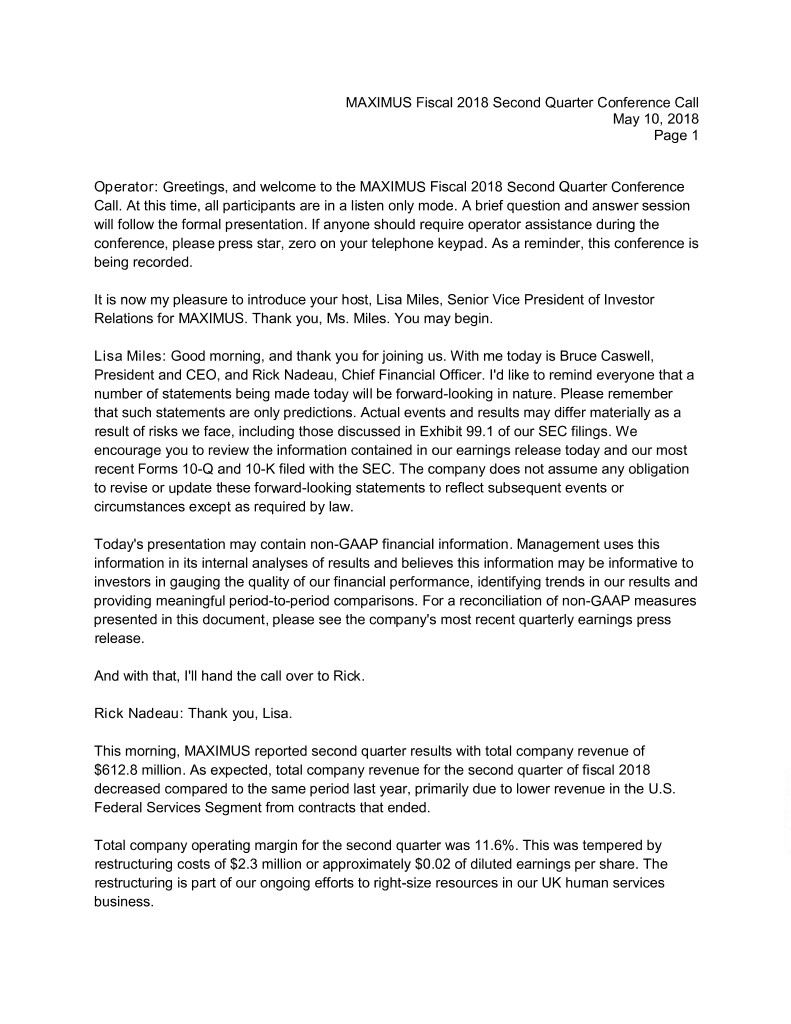
MAXIMUS Fiscal 2018 Second Quarter Conference Call May 10, 2018 Page 1 Operator: Greetings, and welcome to the MAXIMUS Fiscal 2018 Second Quarter Conference Call. At this time, all participants are in a listen only mode. A brief question and answer session will follow the formal presentation. If anyone should require operator assistance during the conference, please press star, zero on your telephone keypad. As a reminder, this conference is being recorded. It is now my pleasure to introduce your host, Lisa Miles, Senior Vice President of Investor Relations for MAXIMUS. Thank you, Ms. Miles. You may begin. Lisa Miles: Good morning, and thank you for joining us. With me today is Bruce Caswell, President and CEO, and Rick Nadeau, Chief Financial Officer. I'd like to remind everyone that a number of statements being made today will be forward-looking in nature. Please remember that such statements are only predictions. Actual events and results may differ materially as a result of risks we face, including those discussed in Exhibit 99.1 of our SEC filings. We encourage you to review the information contained in our earnings release today and our most recent Forms 10-Q and 10-K filed with the SEC. The company does not assume any obligation to revise or update these forward-looking statements to reflect subsequent events or circumstances except as required by law. Today's presentation may contain non-GAAP financial information. Management uses this information in its internal analyses of results and believes this information may be informative to investors in gauging the quality of our financial performance, identifying trends in our results and providing meaningful period-to-period comparisons. For a reconciliation of non-GAAP measures presented in this document, please see the company's most recent quarterly earnings press release. And with that, I'll hand the call over to Rick. Rick Nadeau: Thank you, Lisa. This morning, MAXIMUS reported second quarter results with total company revenue of $612.8 million. As expected, total company revenue for the second quarter of fiscal 2018 decreased compared to the same period last year, primarily due to lower revenue in the U.S. Federal Services Segment from contracts that ended. Total company operating margin for the second quarter was 11.6%. This was tempered by restructuring costs of $2.3 million or approximately $0.02 of diluted earnings per share. The restructuring is part of our ongoing efforts to right-size resources in our UK human services business.
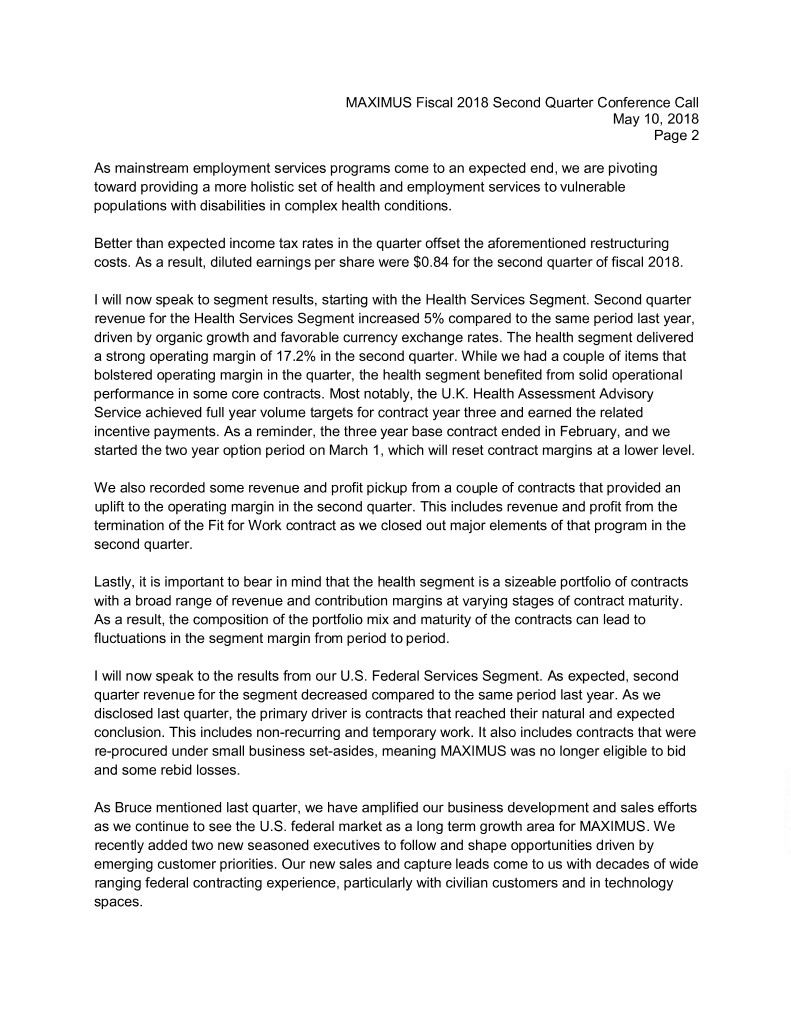
MAXIMUS Fiscal 2018 Second Quarter Conference Call May 10, 2018 Page 2 As mainstream employment services programs come to an expected end, we are pivoting toward providing a more holistic set of health and employment services to vulnerable populations with disabilities in complex health conditions. Better than expected income tax rates in the quarter offset the aforementioned restructuring costs. As a result, diluted earnings per share were $0.84 for the second quarter of fiscal 2018. I will now speak to segment results, starting with the Health Services Segment. Second quarter revenue for the Health Services Segment increased 5% compared to the same period last year, driven by organic growth and favorable currency exchange rates. The health segment delivered a strong operating margin of 17.2% in the second quarter. While we had a couple of items that bolstered operating margin in the quarter, the health segment benefited from solid operational performance in some core contracts. Most notably, the U.K. Health Assessment Advisory Service achieved full year volume targets for contract year three and earned the related incentive payments. As a reminder, the three year base contract ended in February, and we started the two year option period on March 1, which will reset contract margins at a lower level. We also recorded some revenue and profit pickup from a couple of contracts that provided an uplift to the operating margin in the second quarter. This includes revenue and profit from the termination of the Fit for Work contract as we closed out major elements of that program in the second quarter. Lastly, it is important to bear in mind that the health segment is a sizeable portfolio of contracts with a broad range of revenue and contribution margins at varying stages of contract maturity. As a result, the composition of the portfolio mix and maturity of the contracts can lead to fluctuations in the segment margin from period to period. I will now speak to the results from our U.S. Federal Services Segment. As expected, second quarter revenue for the segment decreased compared to the same period last year. As we disclosed last quarter, the primary driver is contracts that reached their natural and expected conclusion. This includes non-recurring and temporary work. It also includes contracts that were re-procured under small business set-asides, meaning MAXIMUS was no longer eligible to bid and some rebid losses. As Bruce mentioned last quarter, we have amplified our business development and sales efforts as we continue to see the U.S. federal market as a long term growth area for MAXIMUS. We recently added two new seasoned executives to follow and shape opportunities driven by emerging customer priorities. Our new sales and capture leads come to us with decades of wide ranging federal contracting experience, particularly with civilian customers and in technology spaces.
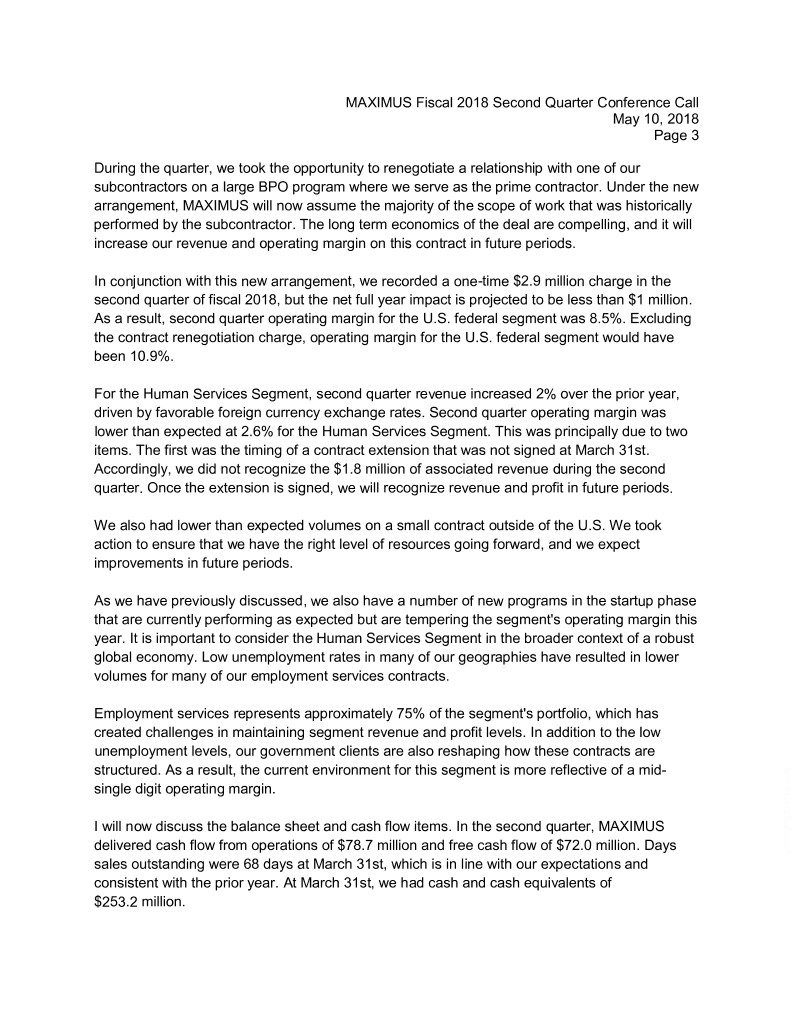
MAXIMUS Fiscal 2018 Second Quarter Conference Call May 10, 2018 Page 3 During the quarter, we took the opportunity to renegotiate a relationship with one of our subcontractors on a large BPO program where we serve as the prime contractor. Under the new arrangement, MAXIMUS will now assume the majority of the scope of work that was historically performed by the subcontractor. The long term economics of the deal are compelling, and it will increase our revenue and operating margin on this contract in future periods. In conjunction with this new arrangement, we recorded a one-time $2.9 million charge in the second quarter of fiscal 2018, but the net full year impact is projected to be less than $1 million. As a result, second quarter operating margin for the U.S. federal segment was 8.5%. Excluding the contract renegotiation charge, operating margin for the U.S. federal segment would have been 10.9%. For the Human Services Segment, second quarter revenue increased 2% over the prior year, driven by favorable foreign currency exchange rates. Second quarter operating margin was lower than expected at 2.6% for the Human Services Segment. This was principally due to two items. The first was the timing of a contract extension that was not signed at March 31st. Accordingly, we did not recognize the $1.8 million of associated revenue during the second quarter. Once the extension is signed, we will recognize revenue and profit in future periods. We also had lower than expected volumes on a small contract outside of the U.S. We took action to ensure that we have the right level of resources going forward, and we expect improvements in future periods. As we have previously discussed, we also have a number of new programs in the startup phase that are currently performing as expected but are tempering the segment's operating margin this year. It is important to consider the Human Services Segment in the broader context of a robust global economy. Low unemployment rates in many of our geographies have resulted in lower volumes for many of our employment services contracts. Employment services represents approximately 75% of the segment's portfolio, which has created challenges in maintaining segment revenue and profit levels. In addition to the low unemployment levels, our government clients are also reshaping how these contracts are structured. As a result, the current environment for this segment is more reflective of a mid- single digit operating margin. I will now discuss the balance sheet and cash flow items. In the second quarter, MAXIMUS delivered cash flow from operations of $78.7 million and free cash flow of $72.0 million. Days sales outstanding were 68 days at March 31st, which is in line with our expectations and consistent with the prior year. At March 31st, we had cash and cash equivalents of $253.2 million.
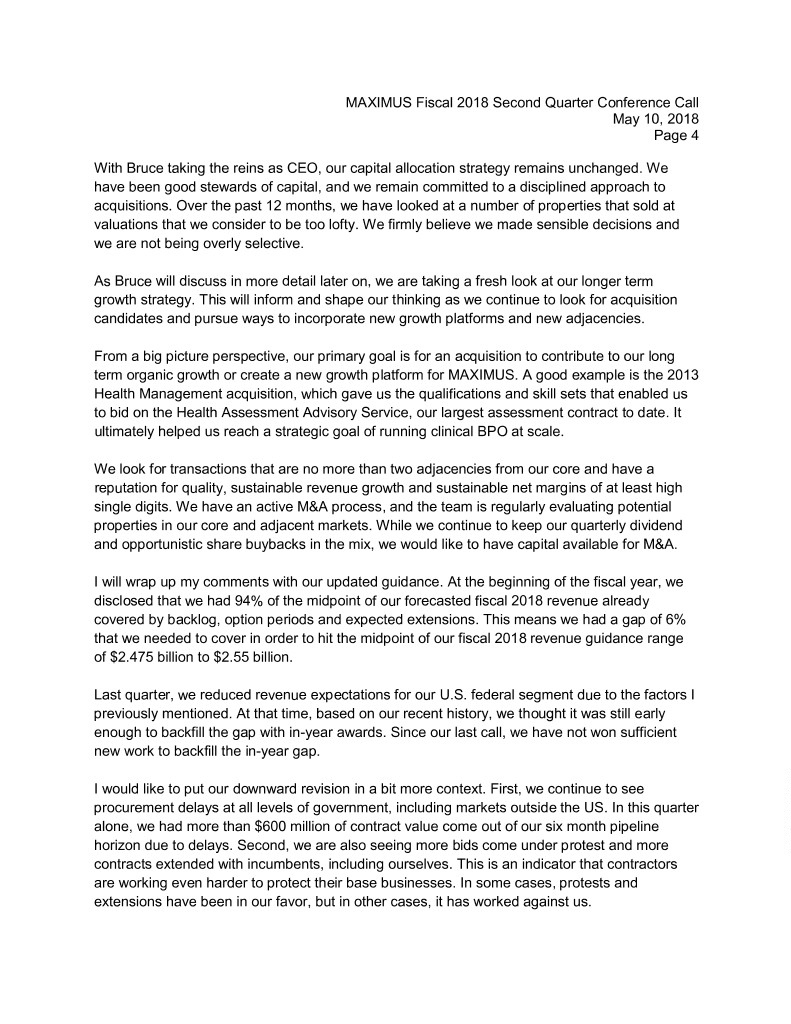
MAXIMUS Fiscal 2018 Second Quarter Conference Call May 10, 2018 Page 4 With Bruce taking the reins as CEO, our capital allocation strategy remains unchanged. We have been good stewards of capital, and we remain committed to a disciplined approach to acquisitions. Over the past 12 months, we have looked at a number of properties that sold at valuations that we consider to be too lofty. We firmly believe we made sensible decisions and we are not being overly selective. As Bruce will discuss in more detail later on, we are taking a fresh look at our longer term growth strategy. This will inform and shape our thinking as we continue to look for acquisition candidates and pursue ways to incorporate new growth platforms and new adjacencies. From a big picture perspective, our primary goal is for an acquisition to contribute to our long term organic growth or create a new growth platform for MAXIMUS. A good example is the 2013 Health Management acquisition, which gave us the qualifications and skill sets that enabled us to bid on the Health Assessment Advisory Service, our largest assessment contract to date. It ultimately helped us reach a strategic goal of running clinical BPO at scale. We look for transactions that are no more than two adjacencies from our core and have a reputation for quality, sustainable revenue growth and sustainable net margins of at least high single digits. We have an active M&A process, and the team is regularly evaluating potential properties in our core and adjacent markets. While we continue to keep our quarterly dividend and opportunistic share buybacks in the mix, we would like to have capital available for M&A. I will wrap up my comments with our updated guidance. At the beginning of the fiscal year, we disclosed that we had 94% of the midpoint of our forecasted fiscal 2018 revenue already covered by backlog, option periods and expected extensions. This means we had a gap of 6% that we needed to cover in order to hit the midpoint of our fiscal 2018 revenue guidance range of $2.475 billion to $2.55 billion. Last quarter, we reduced revenue expectations for our U.S. federal segment due to the factors I previously mentioned. At that time, based on our recent history, we thought it was still early enough to backfill the gap with in-year awards. Since our last call, we have not won sufficient new work to backfill the in-year gap. I would like to put our downward revision in a bit more context. First, we continue to see procurement delays at all levels of government, including markets outside the US. In this quarter alone, we had more than $600 million of contract value come out of our six month pipeline horizon due to delays. Second, we are also seeing more bids come under protest and more contracts extended with incumbents, including ourselves. This is an indicator that contractors are working even harder to protect their base businesses. In some cases, protests and extensions have been in our favor, but in other cases, it has worked against us.
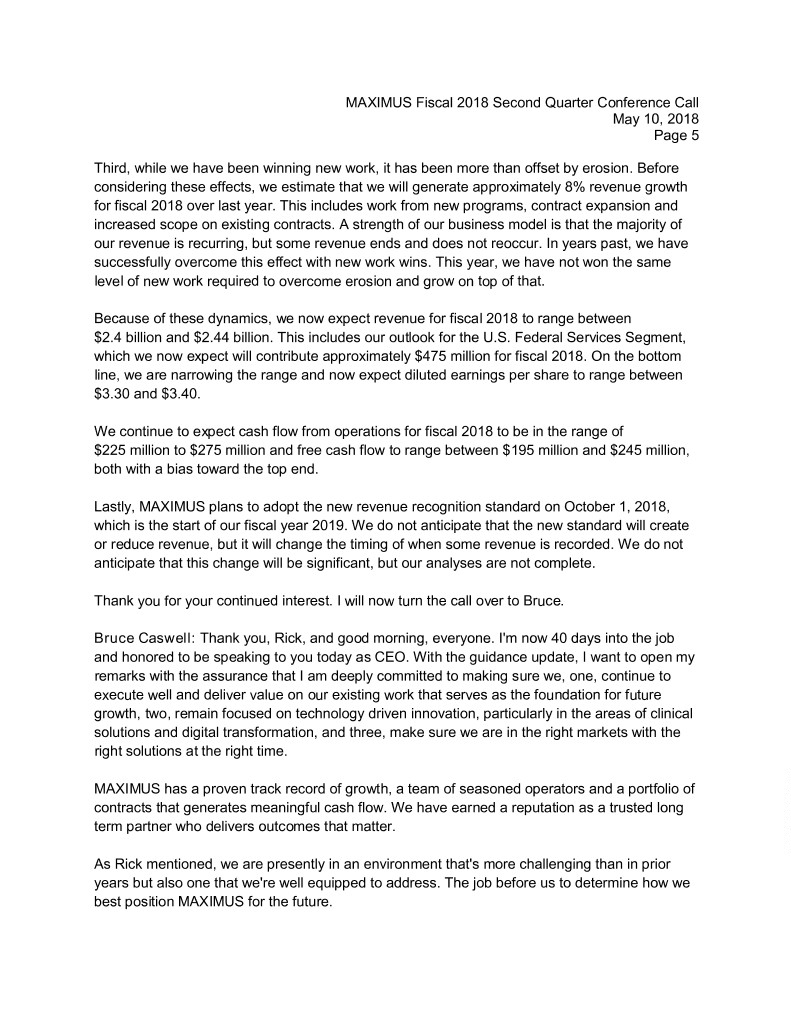
MAXIMUS Fiscal 2018 Second Quarter Conference Call May 10, 2018 Page 5 Third, while we have been winning new work, it has been more than offset by erosion. Before considering these effects, we estimate that we will generate approximately 8% revenue growth for fiscal 2018 over last year. This includes work from new programs, contract expansion and increased scope on existing contracts. A strength of our business model is that the majority of our revenue is recurring, but some revenue ends and does not reoccur. In years past, we have successfully overcome this effect with new work wins. This year, we have not won the same level of new work required to overcome erosion and grow on top of that. Because of these dynamics, we now expect revenue for fiscal 2018 to range between $2.4 billion and $2.44 billion. This includes our outlook for the U.S. Federal Services Segment, which we now expect will contribute approximately $475 million for fiscal 2018. On the bottom line, we are narrowing the range and now expect diluted earnings per share to range between $3.30 and $3.40. We continue to expect cash flow from operations for fiscal 2018 to be in the range of $225 million to $275 million and free cash flow to range between $195 million and $245 million, both with a bias toward the top end. Lastly, MAXIMUS plans to adopt the new revenue recognition standard on October 1, 2018, which is the start of our fiscal year 2019. We do not anticipate that the new standard will create or reduce revenue, but it will change the timing of when some revenue is recorded. We do not anticipate that this change will be significant, but our analyses are not complete. Thank you for your continued interest. I will now turn the call over to Bruce. Bruce Caswell: Thank you, Rick, and good morning, everyone. I'm now 40 days into the job and honored to be speaking to you today as CEO. With the guidance update, I want to open my remarks with the assurance that I am deeply committed to making sure we, one, continue to execute well and deliver value on our existing work that serves as the foundation for future growth, two, remain focused on technology driven innovation, particularly in the areas of clinical solutions and digital transformation, and three, make sure we are in the right markets with the right solutions at the right time. MAXIMUS has a proven track record of growth, a team of seasoned operators and a portfolio of contracts that generates meaningful cash flow. We have earned a reputation as a trusted long term partner who delivers outcomes that matter. As Rick mentioned, we are presently in an environment that's more challenging than in prior years but also one that we're well equipped to address. The job before us to determine how we best position MAXIMUS for the future.
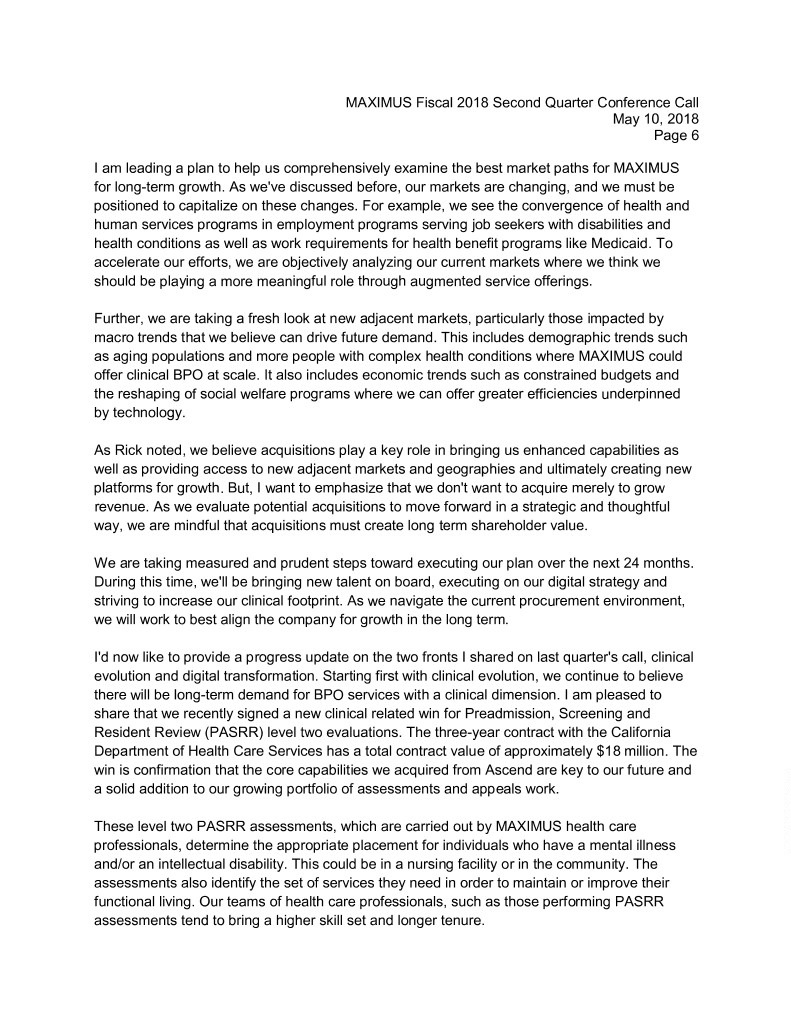
MAXIMUS Fiscal 2018 Second Quarter Conference Call May 10, 2018 Page 6 I am leading a plan to help us comprehensively examine the best market paths for MAXIMUS for long-term growth. As we've discussed before, our markets are changing, and we must be positioned to capitalize on these changes. For example, we see the convergence of health and human services programs in employment programs serving job seekers with disabilities and health conditions as well as work requirements for health benefit programs like Medicaid. To accelerate our efforts, we are objectively analyzing our current markets where we think we should be playing a more meaningful role through augmented service offerings. Further, we are taking a fresh look at new adjacent markets, particularly those impacted by macro trends that we believe can drive future demand. This includes demographic trends such as aging populations and more people with complex health conditions where MAXIMUS could offer clinical BPO at scale. It also includes economic trends such as constrained budgets and the reshaping of social welfare programs where we can offer greater efficiencies underpinned by technology. As Rick noted, we believe acquisitions play a key role in bringing us enhanced capabilities as well as providing access to new adjacent markets and geographies and ultimately creating new platforms for growth. But, I want to emphasize that we don't want to acquire merely to grow revenue. As we evaluate potential acquisitions to move forward in a strategic and thoughtful way, we are mindful that acquisitions must create long term shareholder value. We are taking measured and prudent steps toward executing our plan over the next 24 months. During this time, we'll be bringing new talent on board, executing on our digital strategy and striving to increase our clinical footprint. As we navigate the current procurement environment, we will work to best align the company for growth in the long term. I'd now like to provide a progress update on the two fronts I shared on last quarter's call, clinical evolution and digital transformation. Starting first with clinical evolution, we continue to believe there will be long-term demand for BPO services with a clinical dimension. I am pleased to share that we recently signed a new clinical related win for Preadmission, Screening and Resident Review (PASRR) level two evaluations. The three-year contract with the California Department of Health Care Services has a total contract value of approximately $18 million. The win is confirmation that the core capabilities we acquired from Ascend are key to our future and a solid addition to our growing portfolio of assessments and appeals work. These level two PASRR assessments, which are carried out by MAXIMUS health care professionals, determine the appropriate placement for individuals who have a mental illness and/or an intellectual disability. This could be in a nursing facility or in the community. The assessments also identify the set of services they need in order to maintain or improve their functional living. Our teams of health care professionals, such as those performing PASRR assessments tend to bring a higher skill set and longer tenure.
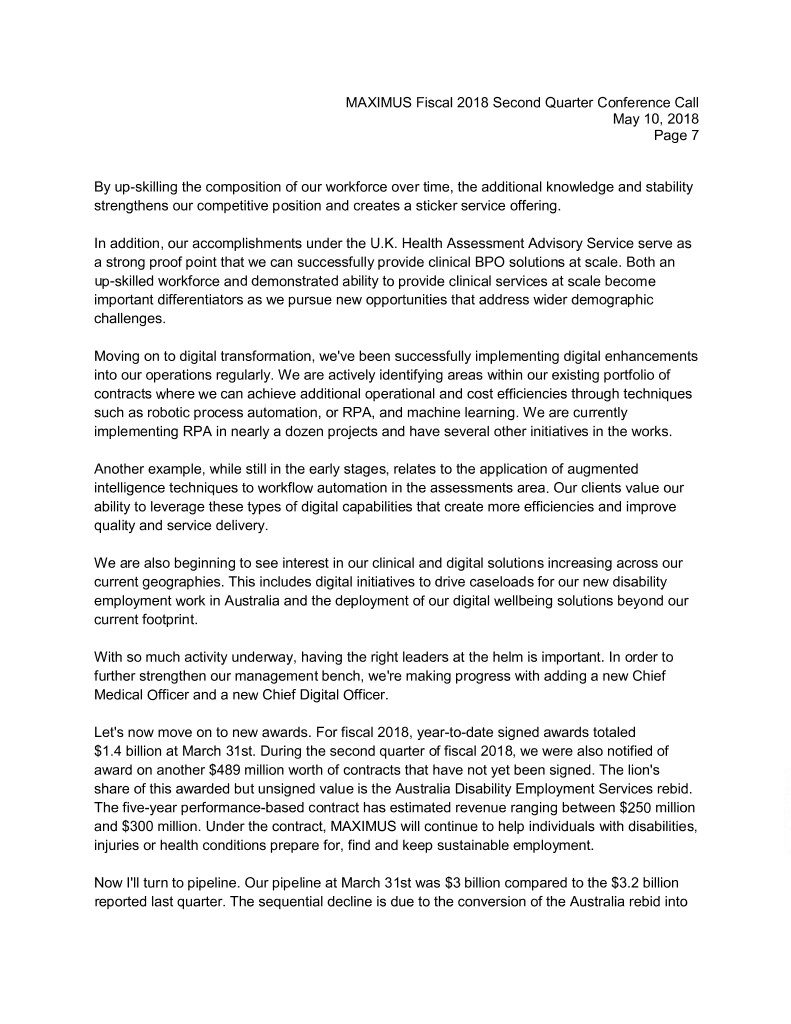
MAXIMUS Fiscal 2018 Second Quarter Conference Call May 10, 2018 Page 7 By up-skilling the composition of our workforce over time, the additional knowledge and stability strengthens our competitive position and creates a sticker service offering. In addition, our accomplishments under the U.K. Health Assessment Advisory Service serve as a strong proof point that we can successfully provide clinical BPO solutions at scale. Both an up-skilled workforce and demonstrated ability to provide clinical services at scale become important differentiators as we pursue new opportunities that address wider demographic challenges. Moving on to digital transformation, we've been successfully implementing digital enhancements into our operations regularly. We are actively identifying areas within our existing portfolio of contracts where we can achieve additional operational and cost efficiencies through techniques such as robotic process automation, or RPA, and machine learning. We are currently implementing RPA in nearly a dozen projects and have several other initiatives in the works. Another example, while still in the early stages, relates to the application of augmented intelligence techniques to workflow automation in the assessments area. Our clients value our ability to leverage these types of digital capabilities that create more efficiencies and improve quality and service delivery. We are also beginning to see interest in our clinical and digital solutions increasing across our current geographies. This includes digital initiatives to drive caseloads for our new disability employment work in Australia and the deployment of our digital wellbeing solutions beyond our current footprint. With so much activity underway, having the right leaders at the helm is important. In order to further strengthen our management bench, we're making progress with adding a new Chief Medical Officer and a new Chief Digital Officer. Let's now move on to new awards. For fiscal 2018, year-to-date signed awards totaled $1.4 billion at March 31st. During the second quarter of fiscal 2018, we were also notified of award on another $489 million worth of contracts that have not yet been signed. The lion's share of this awarded but unsigned value is the Australia Disability Employment Services rebid. The five-year performance-based contract has estimated revenue ranging between $250 million and $300 million. Under the contract, MAXIMUS will continue to help individuals with disabilities, injuries or health conditions prepare for, find and keep sustainable employment. Now I'll turn to pipeline. Our pipeline at March 31st was $3 billion compared to the $3.2 billion reported last quarter. The sequential decline is due to the conversion of the Australia rebid into
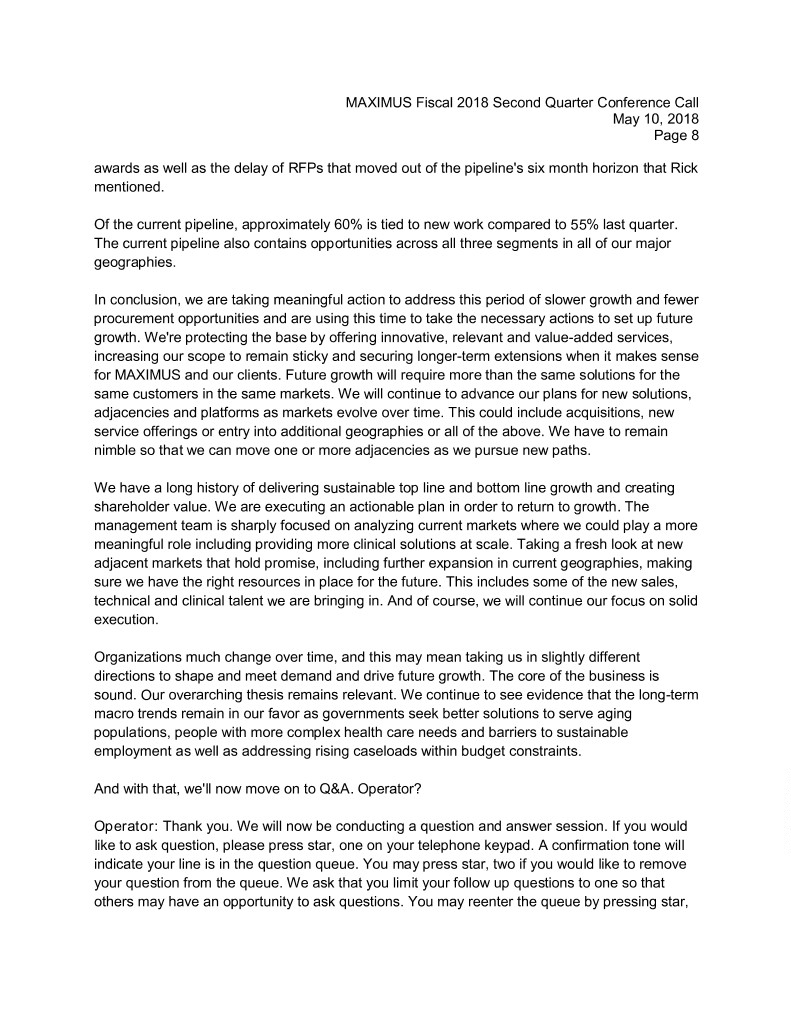
MAXIMUS Fiscal 2018 Second Quarter Conference Call May 10, 2018 Page 8 awards as well as the delay of RFPs that moved out of the pipeline's six month horizon that Rick mentioned. Of the current pipeline, approximately 60% is tied to new work compared to 55% last quarter. The current pipeline also contains opportunities across all three segments in all of our major geographies. In conclusion, we are taking meaningful action to address this period of slower growth and fewer procurement opportunities and are using this time to take the necessary actions to set up future growth. We're protecting the base by offering innovative, relevant and value-added services, increasing our scope to remain sticky and securing longer-term extensions when it makes sense for MAXIMUS and our clients. Future growth will require more than the same solutions for the same customers in the same markets. We will continue to advance our plans for new solutions, adjacencies and platforms as markets evolve over time. This could include acquisitions, new service offerings or entry into additional geographies or all of the above. We have to remain nimble so that we can move one or more adjacencies as we pursue new paths. We have a long history of delivering sustainable top line and bottom line growth and creating shareholder value. We are executing an actionable plan in order to return to growth. The management team is sharply focused on analyzing current markets where we could play a more meaningful role including providing more clinical solutions at scale. Taking a fresh look at new adjacent markets that hold promise, including further expansion in current geographies, making sure we have the right resources in place for the future. This includes some of the new sales, technical and clinical talent we are bringing in. And of course, we will continue our focus on solid execution. Organizations much change over time, and this may mean taking us in slightly different directions to shape and meet demand and drive future growth. The core of the business is sound. Our overarching thesis remains relevant. We continue to see evidence that the long-term macro trends remain in our favor as governments seek better solutions to serve aging populations, people with more complex health care needs and barriers to sustainable employment as well as addressing rising caseloads within budget constraints. And with that, we'll now move on to Q&A. Operator? Operator: Thank you. We will now be conducting a question and answer session. If you would like to ask question, please press star, one on your telephone keypad. A confirmation tone will indicate your line is in the question queue. You may press star, two if you would like to remove your question from the queue. We ask that you limit your follow up questions to one so that others may have an opportunity to ask questions. You may reenter the queue by pressing star,
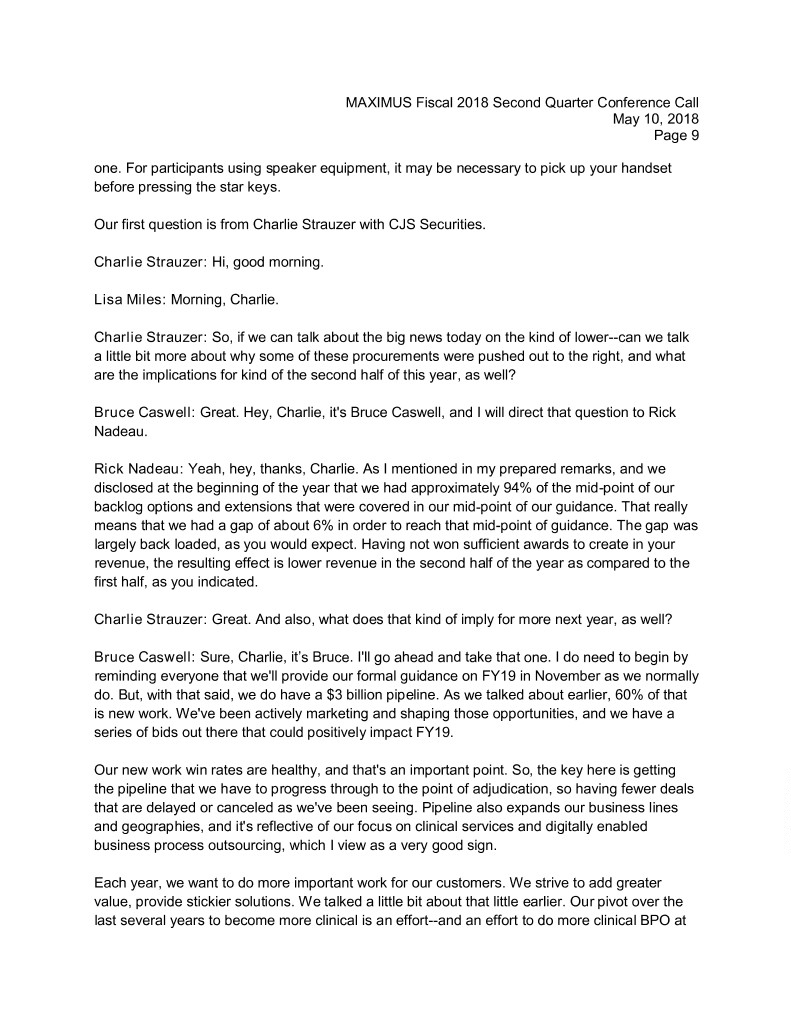
MAXIMUS Fiscal 2018 Second Quarter Conference Call May 10, 2018 Page 9 one. For participants using speaker equipment, it may be necessary to pick up your handset before pressing the star keys. Our first question is from Charlie Strauzer with CJS Securities. Charlie Strauzer: Hi, good morning. Lisa Miles: Morning, Charlie. Charlie Strauzer: So, if we can talk about the big news today on the kind of lower--can we talk a little bit more about why some of these procurements were pushed out to the right, and what are the implications for kind of the second half of this year, as well? Bruce Caswell: Great. Hey, Charlie, it's Bruce Caswell, and I will direct that question to Rick Nadeau. Rick Nadeau: Yeah, hey, thanks, Charlie. As I mentioned in my prepared remarks, and we disclosed at the beginning of the year that we had approximately 94% of the mid-point of our backlog options and extensions that were covered in our mid-point of our guidance. That really means that we had a gap of about 6% in order to reach that mid-point of guidance. The gap was largely back loaded, as you would expect. Having not won sufficient awards to create in your revenue, the resulting effect is lower revenue in the second half of the year as compared to the first half, as you indicated. Charlie Strauzer: Great. And also, what does that kind of imply for more next year, as well? Bruce Caswell: Sure, Charlie, it’s Bruce. I'll go ahead and take that one. I do need to begin by reminding everyone that we'll provide our formal guidance on FY19 in November as we normally do. But, with that said, we do have a $3 billion pipeline. As we talked about earlier, 60% of that is new work. We've been actively marketing and shaping those opportunities, and we have a series of bids out there that could positively impact FY19. Our new work win rates are healthy, and that's an important point. So, the key here is getting the pipeline that we have to progress through to the point of adjudication, so having fewer deals that are delayed or canceled as we've been seeing. Pipeline also expands our business lines and geographies, and it's reflective of our focus on clinical services and digitally enabled business process outsourcing, which I view as a very good sign. Each year, we want to do more important work for our customers. We strive to add greater value, provide stickier solutions. We talked a little bit about that little earlier. Our pivot over the last several years to become more clinical is an effort--and an effort to do more clinical BPO at
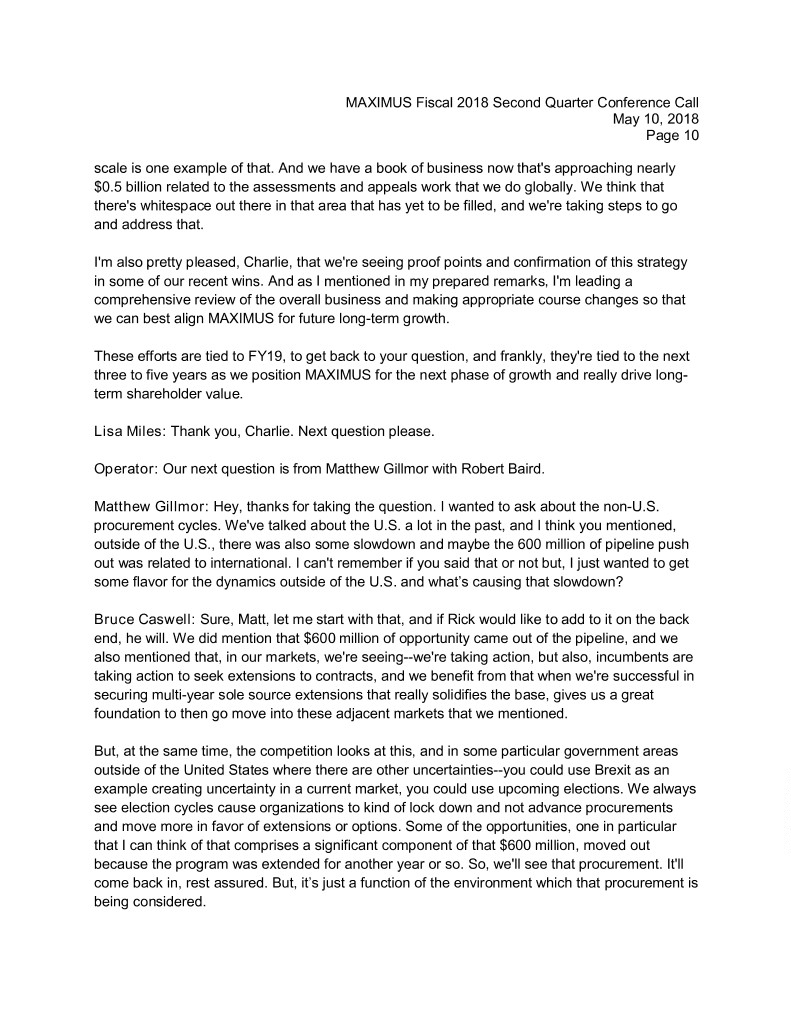
MAXIMUS Fiscal 2018 Second Quarter Conference Call May 10, 2018 Page 10 scale is one example of that. And we have a book of business now that's approaching nearly $0.5 billion related to the assessments and appeals work that we do globally. We think that there's whitespace out there in that area that has yet to be filled, and we're taking steps to go and address that. I'm also pretty pleased, Charlie, that we're seeing proof points and confirmation of this strategy in some of our recent wins. And as I mentioned in my prepared remarks, I'm leading a comprehensive review of the overall business and making appropriate course changes so that we can best align MAXIMUS for future long-term growth. These efforts are tied to FY19, to get back to your question, and frankly, they're tied to the next three to five years as we position MAXIMUS for the next phase of growth and really drive long- term shareholder value. Lisa Miles: Thank you, Charlie. Next question please. Operator: Our next question is from Matthew Gillmor with Robert Baird. Matthew Gillmor: Hey, thanks for taking the question. I wanted to ask about the non-U.S. procurement cycles. We've talked about the U.S. a lot in the past, and I think you mentioned, outside of the U.S., there was also some slowdown and maybe the 600 million of pipeline push out was related to international. I can't remember if you said that or not but, I just wanted to get some flavor for the dynamics outside of the U.S. and what’s causing that slowdown? Bruce Caswell: Sure, Matt, let me start with that, and if Rick would like to add to it on the back end, he will. We did mention that $600 million of opportunity came out of the pipeline, and we also mentioned that, in our markets, we're seeing--we're taking action, but also, incumbents are taking action to seek extensions to contracts, and we benefit from that when we're successful in securing multi-year sole source extensions that really solidifies the base, gives us a great foundation to then go move into these adjacent markets that we mentioned. But, at the same time, the competition looks at this, and in some particular government areas outside of the United States where there are other uncertainties--you could use Brexit as an example creating uncertainty in a current market, you could use upcoming elections. We always see election cycles cause organizations to kind of lock down and not advance procurements and move more in favor of extensions or options. Some of the opportunities, one in particular that I can think of that comprises a significant component of that $600 million, moved out because the program was extended for another year or so. So, we'll see that procurement. It'll come back in, rest assured. But, it’s just a function of the environment which that procurement is being considered.
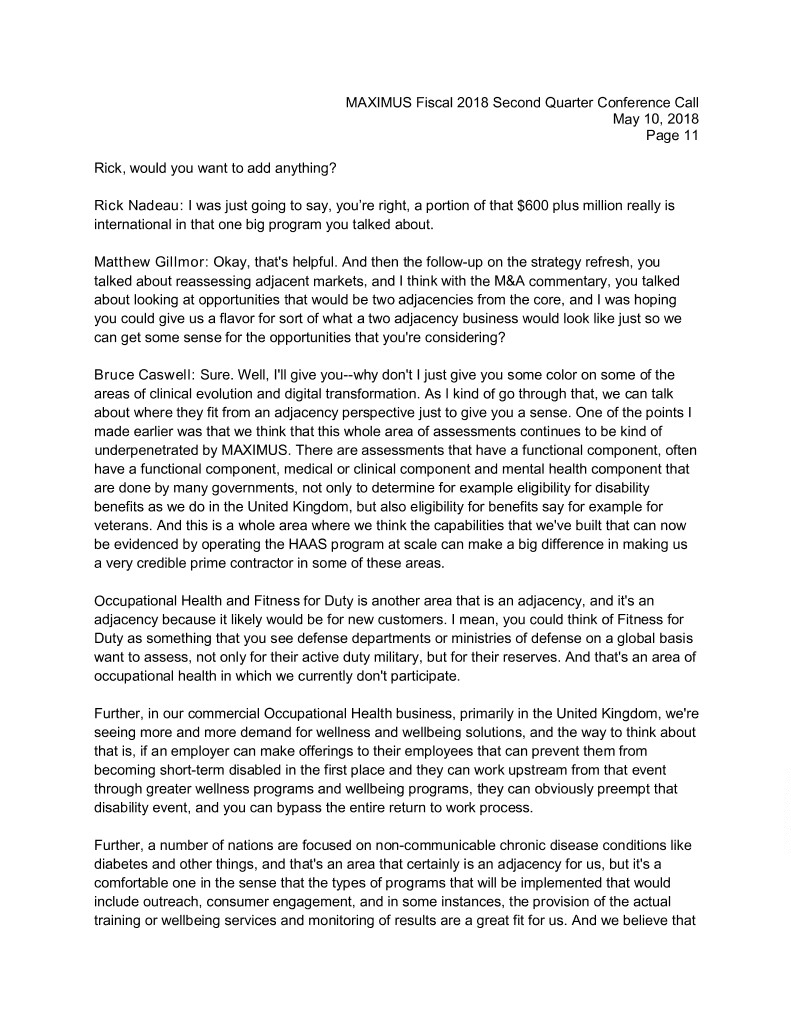
MAXIMUS Fiscal 2018 Second Quarter Conference Call May 10, 2018 Page 11 Rick, would you want to add anything? Rick Nadeau: I was just going to say, you’re right, a portion of that $600 plus million really is international in that one big program you talked about. Matthew Gillmor: Okay, that's helpful. And then the follow-up on the strategy refresh, you talked about reassessing adjacent markets, and I think with the M&A commentary, you talked about looking at opportunities that would be two adjacencies from the core, and I was hoping you could give us a flavor for sort of what a two adjacency business would look like just so we can get some sense for the opportunities that you're considering? Bruce Caswell: Sure. Well, I'll give you--why don't I just give you some color on some of the areas of clinical evolution and digital transformation. As I kind of go through that, we can talk about where they fit from an adjacency perspective just to give you a sense. One of the points I made earlier was that we think that this whole area of assessments continues to be kind of underpenetrated by MAXIMUS. There are assessments that have a functional component, often have a functional component, medical or clinical component and mental health component that are done by many governments, not only to determine for example eligibility for disability benefits as we do in the United Kingdom, but also eligibility for benefits say for example for veterans. And this is a whole area where we think the capabilities that we've built that can now be evidenced by operating the HAAS program at scale can make a big difference in making us a very credible prime contractor in some of these areas. Occupational Health and Fitness for Duty is another area that is an adjacency, and it's an adjacency because it likely would be for new customers. I mean, you could think of Fitness for Duty as something that you see defense departments or ministries of defense on a global basis want to assess, not only for their active duty military, but for their reserves. And that's an area of occupational health in which we currently don't participate. Further, in our commercial Occupational Health business, primarily in the United Kingdom, we're seeing more and more demand for wellness and wellbeing solutions, and the way to think about that is, if an employer can make offerings to their employees that can prevent them from becoming short-term disabled in the first place and they can work upstream from that event through greater wellness programs and wellbeing programs, they can obviously preempt that disability event, and you can bypass the entire return to work process. Further, a number of nations are focused on non-communicable chronic disease conditions like diabetes and other things, and that's an area that certainly is an adjacency for us, but it's a comfortable one in the sense that the types of programs that will be implemented that would include outreach, consumer engagement, and in some instances, the provision of the actual training or wellbeing services and monitoring of results are a great fit for us. And we believe that
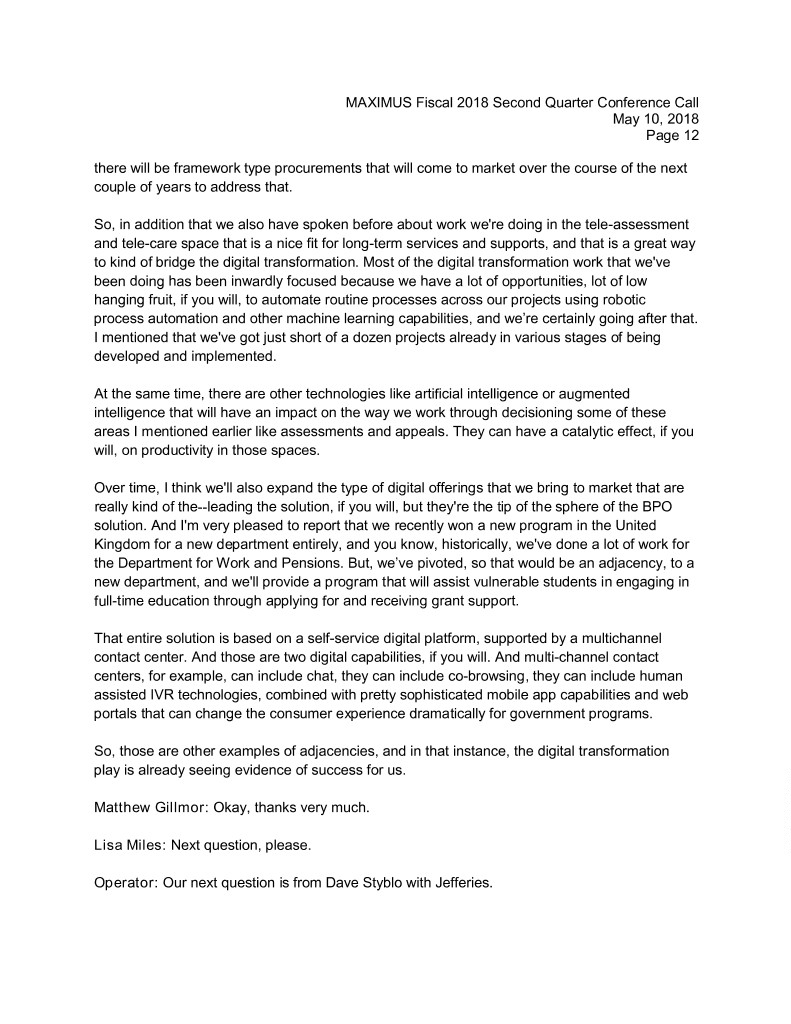
MAXIMUS Fiscal 2018 Second Quarter Conference Call May 10, 2018 Page 12 there will be framework type procurements that will come to market over the course of the next couple of years to address that. So, in addition that we also have spoken before about work we're doing in the tele-assessment and tele-care space that is a nice fit for long-term services and supports, and that is a great way to kind of bridge the digital transformation. Most of the digital transformation work that we've been doing has been inwardly focused because we have a lot of opportunities, lot of low hanging fruit, if you will, to automate routine processes across our projects using robotic process automation and other machine learning capabilities, and we’re certainly going after that. I mentioned that we've got just short of a dozen projects already in various stages of being developed and implemented. At the same time, there are other technologies like artificial intelligence or augmented intelligence that will have an impact on the way we work through decisioning some of these areas I mentioned earlier like assessments and appeals. They can have a catalytic effect, if you will, on productivity in those spaces. Over time, I think we'll also expand the type of digital offerings that we bring to market that are really kind of the--leading the solution, if you will, but they're the tip of the sphere of the BPO solution. And I'm very pleased to report that we recently won a new program in the United Kingdom for a new department entirely, and you know, historically, we've done a lot of work for the Department for Work and Pensions. But, we’ve pivoted, so that would be an adjacency, to a new department, and we'll provide a program that will assist vulnerable students in engaging in full-time education through applying for and receiving grant support. That entire solution is based on a self-service digital platform, supported by a multichannel contact center. And those are two digital capabilities, if you will. And multi-channel contact centers, for example, can include chat, they can include co-browsing, they can include human assisted IVR technologies, combined with pretty sophisticated mobile app capabilities and web portals that can change the consumer experience dramatically for government programs. So, those are other examples of adjacencies, and in that instance, the digital transformation play is already seeing evidence of success for us. Matthew Gillmor: Okay, thanks very much. Lisa Miles: Next question, please. Operator: Our next question is from Dave Styblo with Jefferies.
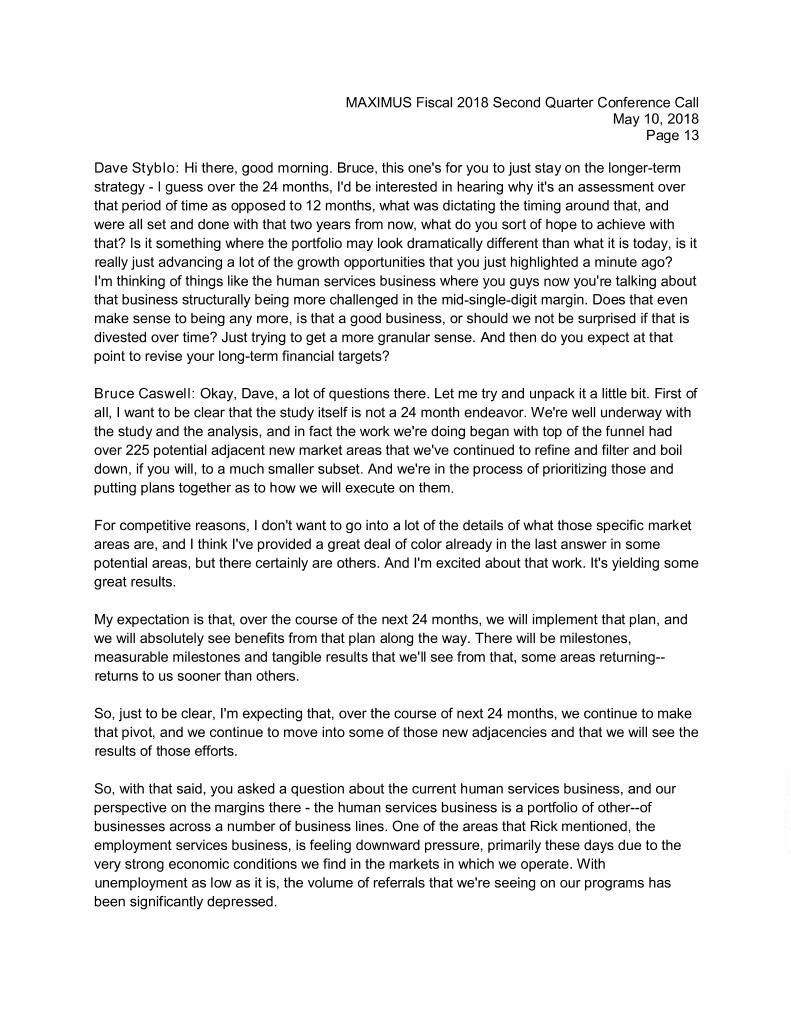
MAXIMUS Fiscal 2018 Second Quarter Conference Call May 10, 2018 Page 13 Dave Styblo: Hi there, good morning. Bruce, this one's for you to just stay on the longer-term strategy - I guess over the 24 months, I'd be interested in hearing why it's an assessment over that period of time as opposed to 12 months, what was dictating the timing around that, and were all set and done with that two years from now, what do you sort of hope to achieve with that? Is it something where the portfolio may look dramatically different than what it is today, is it really just advancing a lot of the growth opportunities that you just highlighted a minute ago? I'm thinking of things like the human services business where you guys now you're talking about that business structurally being more challenged in the mid-single-digit margin. Does that even make sense to being any more, is that a good business, or should we not be surprised if that is divested over time? Just trying to get a more granular sense. And then do you expect at that point to revise your long-term financial targets? Bruce Caswell: Okay, Dave, a lot of questions there. Let me try and unpack it a little bit. First of all, I want to be clear that the study itself is not a 24 month endeavor. We're well underway with the study and the analysis, and in fact the work we're doing began with top of the funnel had over 225 potential adjacent new market areas that we've continued to refine and filter and boil down, if you will, to a much smaller subset. And we're in the process of prioritizing those and putting plans together as to how we will execute on them. For competitive reasons, I don't want to go into a lot of the details of what those specific market areas are, and I think I've provided a great deal of color already in the last answer in some potential areas, but there certainly are others. And I'm excited about that work. It's yielding some great results. My expectation is that, over the course of the next 24 months, we will implement that plan, and we will absolutely see benefits from that plan along the way. There will be milestones, measurable milestones and tangible results that we'll see from that, some areas returning-- returns to us sooner than others. So, just to be clear, I'm expecting that, over the course of next 24 months, we continue to make that pivot, and we continue to move into some of those new adjacencies and that we will see the results of those efforts. So, with that said, you asked a question about the current human services business, and our perspective on the margins there - the human services business is a portfolio of other--of businesses across a number of business lines. One of the areas that Rick mentioned, the employment services business, is feeling downward pressure, primarily these days due to the very strong economic conditions we find in the markets in which we operate. With unemployment as low as it is, the volume of referrals that we're seeing on our programs has been significantly depressed.
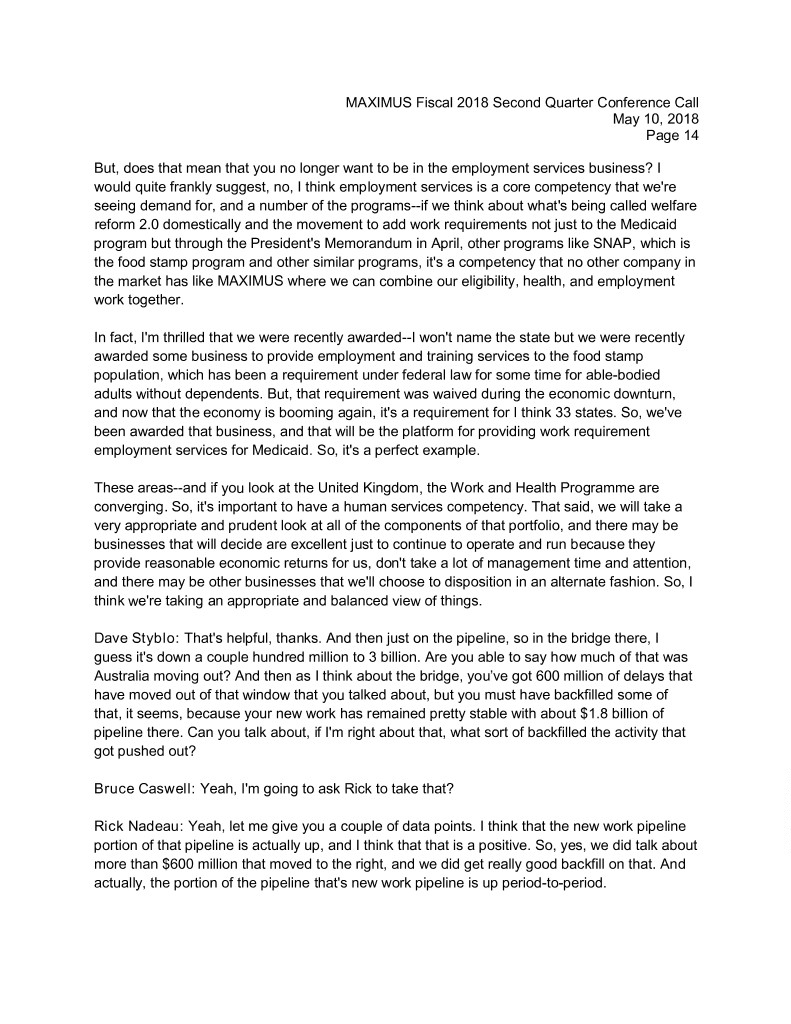
MAXIMUS Fiscal 2018 Second Quarter Conference Call May 10, 2018 Page 14 But, does that mean that you no longer want to be in the employment services business? I would quite frankly suggest, no, I think employment services is a core competency that we're seeing demand for, and a number of the programs--if we think about what's being called welfare reform 2.0 domestically and the movement to add work requirements not just to the Medicaid program but through the President's Memorandum in April, other programs like SNAP, which is the food stamp program and other similar programs, it's a competency that no other company in the market has like MAXIMUS where we can combine our eligibility, health, and employment work together. In fact, I'm thrilled that we were recently awarded--I won't name the state but we were recently awarded some business to provide employment and training services to the food stamp population, which has been a requirement under federal law for some time for able-bodied adults without dependents. But, that requirement was waived during the economic downturn, and now that the economy is booming again, it's a requirement for I think 33 states. So, we've been awarded that business, and that will be the platform for providing work requirement employment services for Medicaid. So, it's a perfect example. These areas--and if you look at the United Kingdom, the Work and Health Programme are converging. So, it's important to have a human services competency. That said, we will take a very appropriate and prudent look at all of the components of that portfolio, and there may be businesses that will decide are excellent just to continue to operate and run because they provide reasonable economic returns for us, don't take a lot of management time and attention, and there may be other businesses that we'll choose to disposition in an alternate fashion. So, I think we're taking an appropriate and balanced view of things. Dave Styblo: That's helpful, thanks. And then just on the pipeline, so in the bridge there, I guess it's down a couple hundred million to 3 billion. Are you able to say how much of that was Australia moving out? And then as I think about the bridge, you’ve got 600 million of delays that have moved out of that window that you talked about, but you must have backfilled some of that, it seems, because your new work has remained pretty stable with about $1.8 billion of pipeline there. Can you talk about, if I'm right about that, what sort of backfilled the activity that got pushed out? Bruce Caswell: Yeah, I'm going to ask Rick to take that? Rick Nadeau: Yeah, let me give you a couple of data points. I think that the new work pipeline portion of that pipeline is actually up, and I think that that is a positive. So, yes, we did talk about more than $600 million that moved to the right, and we did get really good backfill on that. And actually, the portion of the pipeline that's new work pipeline is up period-to-period.
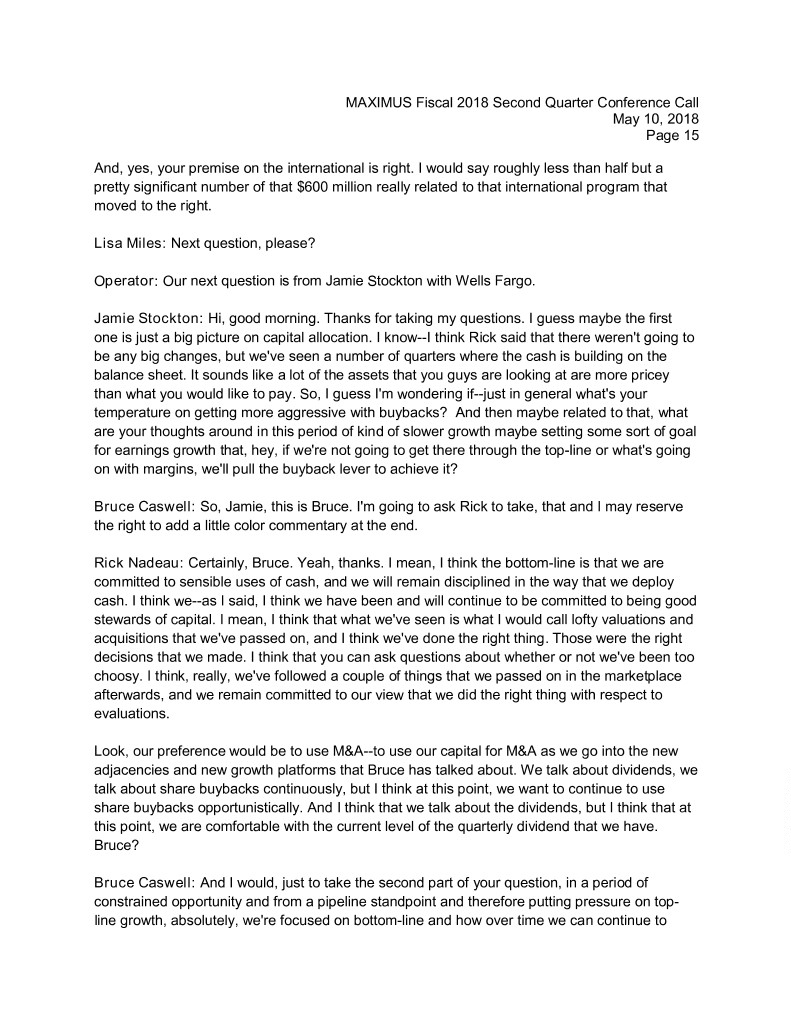
MAXIMUS Fiscal 2018 Second Quarter Conference Call May 10, 2018 Page 15 And, yes, your premise on the international is right. I would say roughly less than half but a pretty significant number of that $600 million really related to that international program that moved to the right. Lisa Miles: Next question, please? Operator: Our next question is from Jamie Stockton with Wells Fargo. Jamie Stockton: Hi, good morning. Thanks for taking my questions. I guess maybe the first one is just a big picture on capital allocation. I know--I think Rick said that there weren't going to be any big changes, but we've seen a number of quarters where the cash is building on the balance sheet. It sounds like a lot of the assets that you guys are looking at are more pricey than what you would like to pay. So, I guess I'm wondering if--just in general what's your temperature on getting more aggressive with buybacks? And then maybe related to that, what are your thoughts around in this period of kind of slower growth maybe setting some sort of goal for earnings growth that, hey, if we're not going to get there through the top-line or what's going on with margins, we'll pull the buyback lever to achieve it? Bruce Caswell: So, Jamie, this is Bruce. I'm going to ask Rick to take, that and I may reserve the right to add a little color commentary at the end. Rick Nadeau: Certainly, Bruce. Yeah, thanks. I mean, I think the bottom-line is that we are committed to sensible uses of cash, and we will remain disciplined in the way that we deploy cash. I think we--as I said, I think we have been and will continue to be committed to being good stewards of capital. I mean, I think that what we've seen is what I would call lofty valuations and acquisitions that we've passed on, and I think we've done the right thing. Those were the right decisions that we made. I think that you can ask questions about whether or not we've been too choosy. I think, really, we've followed a couple of things that we passed on in the marketplace afterwards, and we remain committed to our view that we did the right thing with respect to evaluations. Look, our preference would be to use M&A--to use our capital for M&A as we go into the new adjacencies and new growth platforms that Bruce has talked about. We talk about dividends, we talk about share buybacks continuously, but I think at this point, we want to continue to use share buybacks opportunistically. And I think that we talk about the dividends, but I think that at this point, we are comfortable with the current level of the quarterly dividend that we have. Bruce? Bruce Caswell: And I would, just to take the second part of your question, in a period of constrained opportunity and from a pipeline standpoint and therefore putting pressure on top- line growth, absolutely, we're focused on bottom-line and how over time we can continue to
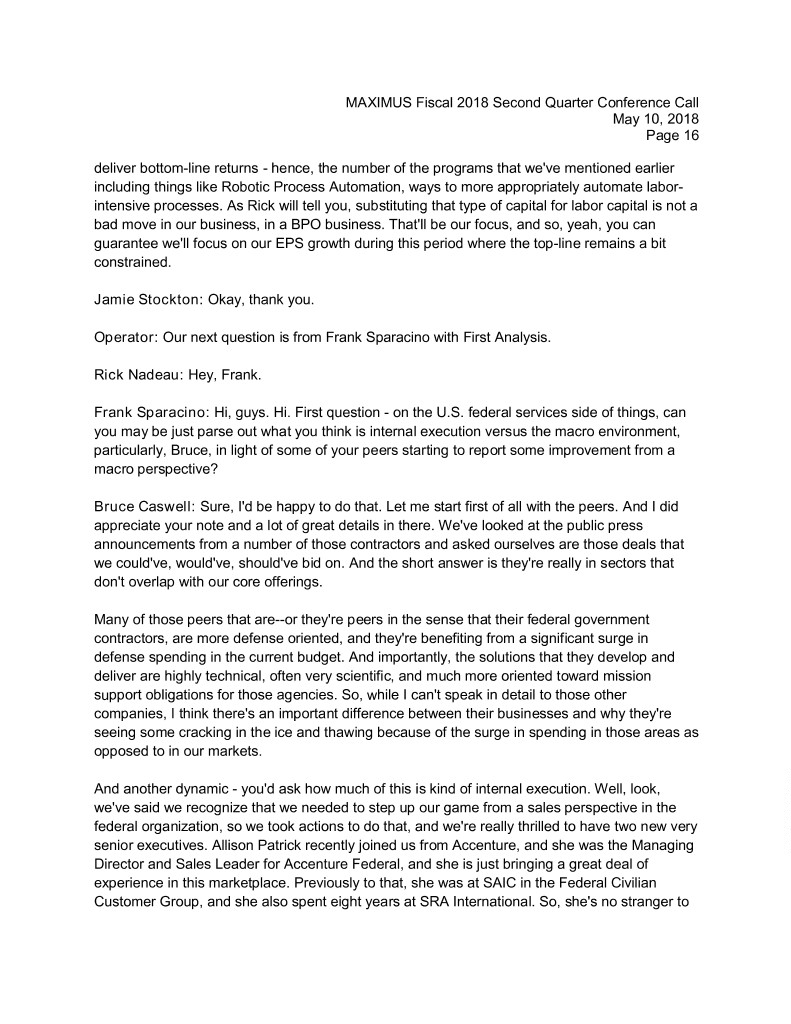
MAXIMUS Fiscal 2018 Second Quarter Conference Call May 10, 2018 Page 16 deliver bottom-line returns - hence, the number of the programs that we've mentioned earlier including things like Robotic Process Automation, ways to more appropriately automate labor- intensive processes. As Rick will tell you, substituting that type of capital for labor capital is not a bad move in our business, in a BPO business. That'll be our focus, and so, yeah, you can guarantee we'll focus on our EPS growth during this period where the top-line remains a bit constrained. Jamie Stockton: Okay, thank you. Operator: Our next question is from Frank Sparacino with First Analysis. Rick Nadeau: Hey, Frank. Frank Sparacino: Hi, guys. Hi. First question - on the U.S. federal services side of things, can you may be just parse out what you think is internal execution versus the macro environment, particularly, Bruce, in light of some of your peers starting to report some improvement from a macro perspective? Bruce Caswell: Sure, I'd be happy to do that. Let me start first of all with the peers. And I did appreciate your note and a lot of great details in there. We've looked at the public press announcements from a number of those contractors and asked ourselves are those deals that we could've, would've, should've bid on. And the short answer is they're really in sectors that don't overlap with our core offerings. Many of those peers that are--or they're peers in the sense that their federal government contractors, are more defense oriented, and they're benefiting from a significant surge in defense spending in the current budget. And importantly, the solutions that they develop and deliver are highly technical, often very scientific, and much more oriented toward mission support obligations for those agencies. So, while I can't speak in detail to those other companies, I think there's an important difference between their businesses and why they're seeing some cracking in the ice and thawing because of the surge in spending in those areas as opposed to in our markets. And another dynamic - you'd ask how much of this is kind of internal execution. Well, look, we've said we recognize that we needed to step up our game from a sales perspective in the federal organization, so we took actions to do that, and we're really thrilled to have two new very senior executives. Allison Patrick recently joined us from Accenture, and she was the Managing Director and Sales Leader for Accenture Federal, and she is just bringing a great deal of experience in this marketplace. Previously to that, she was at SAIC in the Federal Civilian Customer Group, and she also spent eight years at SRA International. So, she's no stranger to
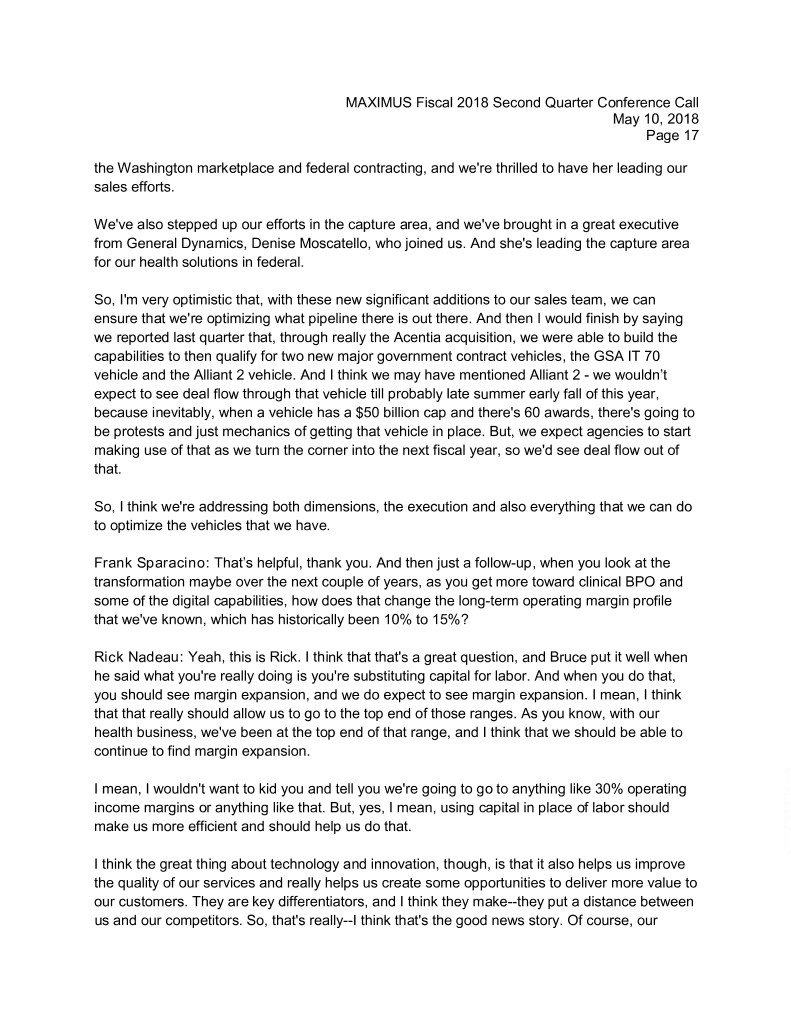
MAXIMUS Fiscal 2018 Second Quarter Conference Call May 10, 2018 Page 17 the Washington marketplace and federal contracting, and we're thrilled to have her leading our sales efforts. We've also stepped up our efforts in the capture area, and we've brought in a great executive from General Dynamics, Denise Moscatello, who joined us. And she's leading the capture area for our health solutions in federal. So, I'm very optimistic that, with these new significant additions to our sales team, we can ensure that we're optimizing what pipeline there is out there. And then I would finish by saying we reported last quarter that, through really the Acentia acquisition, we were able to build the capabilities to then qualify for two new major government contract vehicles, the GSA IT 70 vehicle and the Alliant 2 vehicle. And I think we may have mentioned Alliant 2 - we wouldn’t expect to see deal flow through that vehicle till probably late summer early fall of this year, because inevitably, when a vehicle has a $50 billion cap and there's 60 awards, there's going to be protests and just mechanics of getting that vehicle in place. But, we expect agencies to start making use of that as we turn the corner into the next fiscal year, so we'd see deal flow out of that. So, I think we're addressing both dimensions, the execution and also everything that we can do to optimize the vehicles that we have. Frank Sparacino: That’s helpful, thank you. And then just a follow-up, when you look at the transformation maybe over the next couple of years, as you get more toward clinical BPO and some of the digital capabilities, how does that change the long-term operating margin profile that we've known, which has historically been 10% to 15%? Rick Nadeau: Yeah, this is Rick. I think that that's a great question, and Bruce put it well when he said what you're really doing is you're substituting capital for labor. And when you do that, you should see margin expansion, and we do expect to see margin expansion. I mean, I think that that really should allow us to go to the top end of those ranges. As you know, with our health business, we've been at the top end of that range, and I think that we should be able to continue to find margin expansion. I mean, I wouldn't want to kid you and tell you we're going to go to anything like 30% operating income margins or anything like that. But, yes, I mean, using capital in place of labor should make us more efficient and should help us do that. I think the great thing about technology and innovation, though, is that it also helps us improve the quality of our services and really helps us create some opportunities to deliver more value to our customers. They are key differentiators, and I think they make--they put a distance between us and our competitors. So, that's really--I think that's the good news story. Of course, our
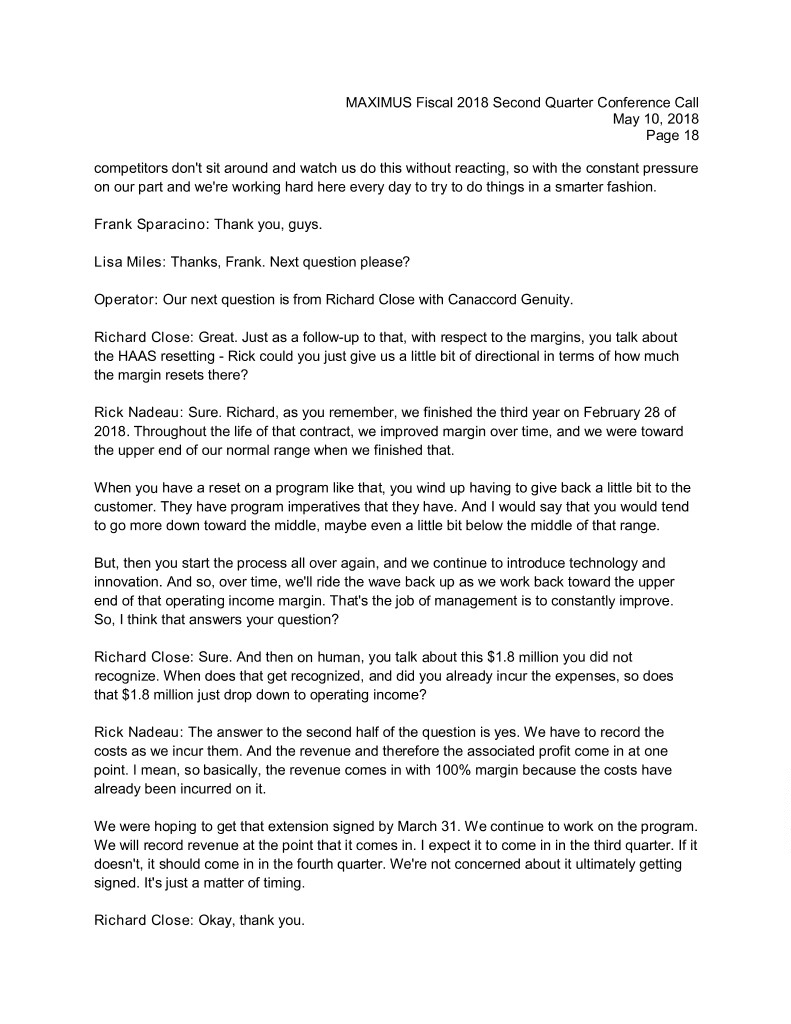
MAXIMUS Fiscal 2018 Second Quarter Conference Call May 10, 2018 Page 18 competitors don't sit around and watch us do this without reacting, so with the constant pressure on our part and we're working hard here every day to try to do things in a smarter fashion. Frank Sparacino: Thank you, guys. Lisa Miles: Thanks, Frank. Next question please? Operator: Our next question is from Richard Close with Canaccord Genuity. Richard Close: Great. Just as a follow-up to that, with respect to the margins, you talk about the HAAS resetting - Rick could you just give us a little bit of directional in terms of how much the margin resets there? Rick Nadeau: Sure. Richard, as you remember, we finished the third year on February 28 of 2018. Throughout the life of that contract, we improved margin over time, and we were toward the upper end of our normal range when we finished that. When you have a reset on a program like that, you wind up having to give back a little bit to the customer. They have program imperatives that they have. And I would say that you would tend to go more down toward the middle, maybe even a little bit below the middle of that range. But, then you start the process all over again, and we continue to introduce technology and innovation. And so, over time, we'll ride the wave back up as we work back toward the upper end of that operating income margin. That's the job of management is to constantly improve. So, I think that answers your question? Richard Close: Sure. And then on human, you talk about this $1.8 million you did not recognize. When does that get recognized, and did you already incur the expenses, so does that $1.8 million just drop down to operating income? Rick Nadeau: The answer to the second half of the question is yes. We have to record the costs as we incur them. And the revenue and therefore the associated profit come in at one point. I mean, so basically, the revenue comes in with 100% margin because the costs have already been incurred on it. We were hoping to get that extension signed by March 31. We continue to work on the program. We will record revenue at the point that it comes in. I expect it to come in in the third quarter. If it doesn't, it should come in in the fourth quarter. We're not concerned about it ultimately getting signed. It's just a matter of timing. Richard Close: Okay, thank you.
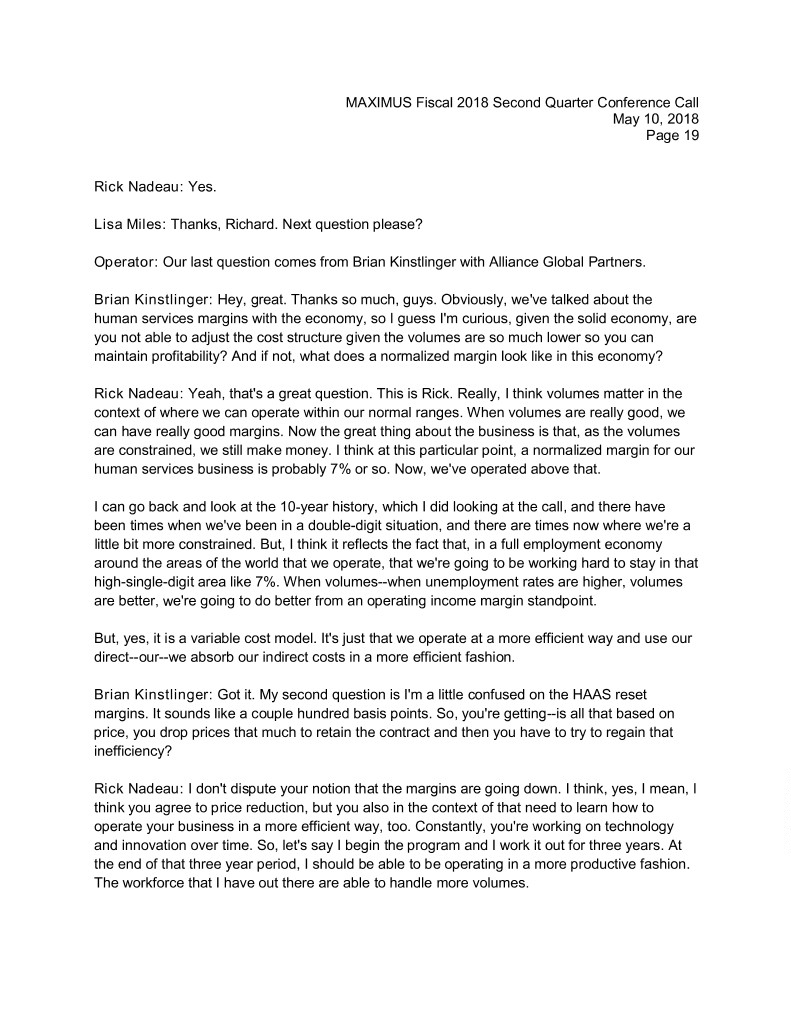
MAXIMUS Fiscal 2018 Second Quarter Conference Call May 10, 2018 Page 19 Rick Nadeau: Yes. Lisa Miles: Thanks, Richard. Next question please? Operator: Our last question comes from Brian Kinstlinger with Alliance Global Partners. Brian Kinstlinger: Hey, great. Thanks so much, guys. Obviously, we've talked about the human services margins with the economy, so I guess I'm curious, given the solid economy, are you not able to adjust the cost structure given the volumes are so much lower so you can maintain profitability? And if not, what does a normalized margin look like in this economy? Rick Nadeau: Yeah, that's a great question. This is Rick. Really, I think volumes matter in the context of where we can operate within our normal ranges. When volumes are really good, we can have really good margins. Now the great thing about the business is that, as the volumes are constrained, we still make money. I think at this particular point, a normalized margin for our human services business is probably 7% or so. Now, we've operated above that. I can go back and look at the 10-year history, which I did looking at the call, and there have been times when we've been in a double-digit situation, and there are times now where we're a little bit more constrained. But, I think it reflects the fact that, in a full employment economy around the areas of the world that we operate, that we're going to be working hard to stay in that high-single-digit area like 7%. When volumes--when unemployment rates are higher, volumes are better, we're going to do better from an operating income margin standpoint. But, yes, it is a variable cost model. It's just that we operate at a more efficient way and use our direct--our--we absorb our indirect costs in a more efficient fashion. Brian Kinstlinger: Got it. My second question is I'm a little confused on the HAAS reset margins. It sounds like a couple hundred basis points. So, you're getting--is all that based on price, you drop prices that much to retain the contract and then you have to try to regain that inefficiency? Rick Nadeau: I don't dispute your notion that the margins are going down. I think, yes, I mean, I think you agree to price reduction, but you also in the context of that need to learn how to operate your business in a more efficient way, too. Constantly, you're working on technology and innovation over time. So, let's say I begin the program and I work it out for three years. At the end of that three year period, I should be able to be operating in a more productive fashion. The workforce that I have out there are able to handle more volumes.
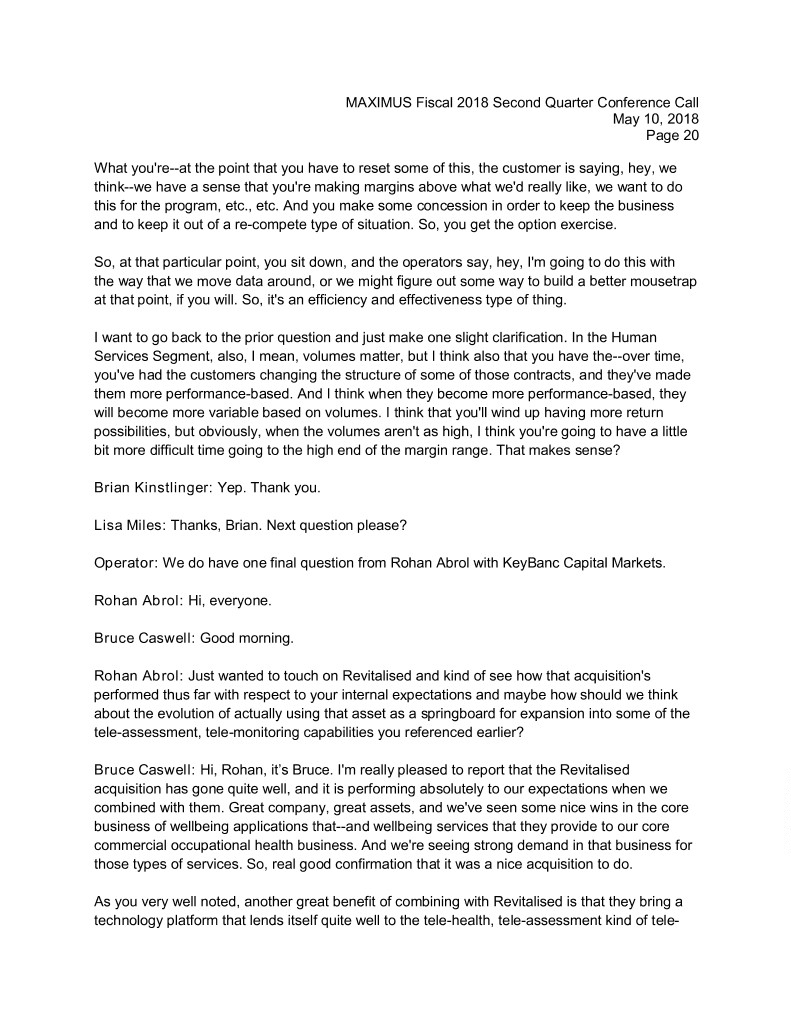
MAXIMUS Fiscal 2018 Second Quarter Conference Call May 10, 2018 Page 20 What you're--at the point that you have to reset some of this, the customer is saying, hey, we think--we have a sense that you're making margins above what we'd really like, we want to do this for the program, etc., etc. And you make some concession in order to keep the business and to keep it out of a re-compete type of situation. So, you get the option exercise. So, at that particular point, you sit down, and the operators say, hey, I'm going to do this with the way that we move data around, or we might figure out some way to build a better mousetrap at that point, if you will. So, it's an efficiency and effectiveness type of thing. I want to go back to the prior question and just make one slight clarification. In the Human Services Segment, also, I mean, volumes matter, but I think also that you have the--over time, you've had the customers changing the structure of some of those contracts, and they've made them more performance-based. And I think when they become more performance-based, they will become more variable based on volumes. I think that you'll wind up having more return possibilities, but obviously, when the volumes aren't as high, I think you're going to have a little bit more difficult time going to the high end of the margin range. That makes sense? Brian Kinstlinger: Yep. Thank you. Lisa Miles: Thanks, Brian. Next question please? Operator: We do have one final question from Rohan Abrol with KeyBanc Capital Markets. Rohan Abrol: Hi, everyone. Bruce Caswell: Good morning. Rohan Abrol: Just wanted to touch on Revitalised and kind of see how that acquisition's performed thus far with respect to your internal expectations and maybe how should we think about the evolution of actually using that asset as a springboard for expansion into some of the tele-assessment, tele-monitoring capabilities you referenced earlier? Bruce Caswell: Hi, Rohan, it’s Bruce. I'm really pleased to report that the Revitalised acquisition has gone quite well, and it is performing absolutely to our expectations when we combined with them. Great company, great assets, and we've seen some nice wins in the core business of wellbeing applications that--and wellbeing services that they provide to our core commercial occupational health business. And we're seeing strong demand in that business for those types of services. So, real good confirmation that it was a nice acquisition to do. As you very well noted, another great benefit of combining with Revitalised is that they bring a technology platform that lends itself quite well to the tele-health, tele-assessment kind of tele-
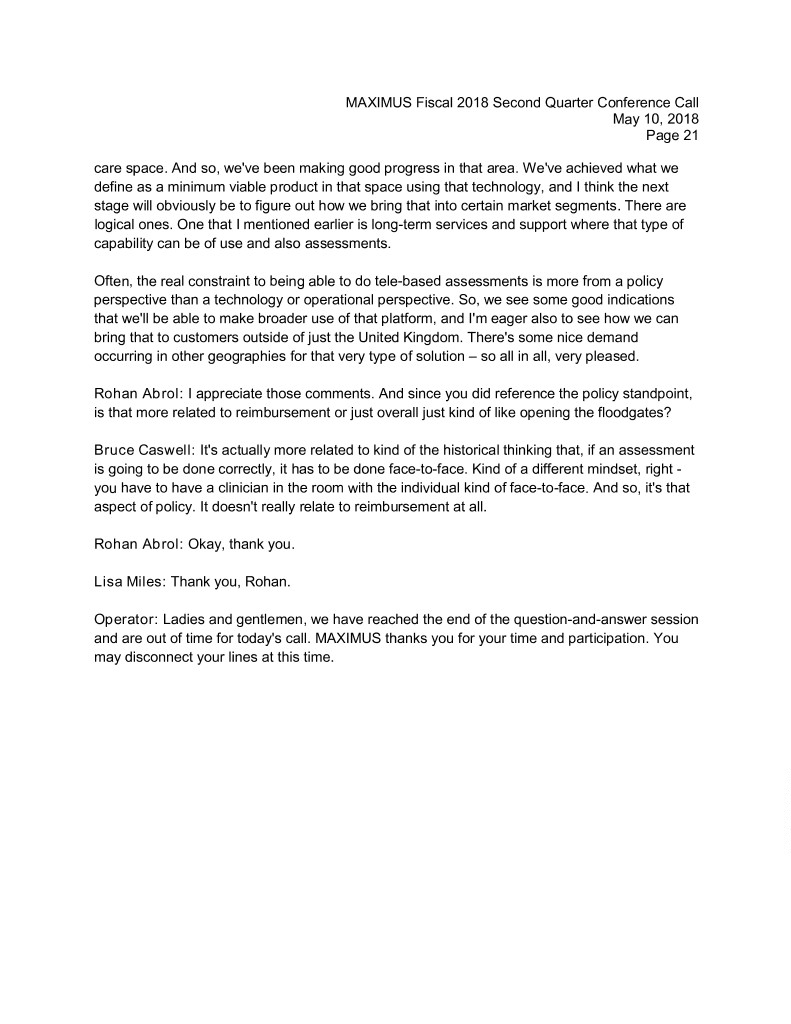
MAXIMUS Fiscal 2018 Second Quarter Conference Call May 10, 2018 Page 21 care space. And so, we've been making good progress in that area. We've achieved what we define as a minimum viable product in that space using that technology, and I think the next stage will obviously be to figure out how we bring that into certain market segments. There are logical ones. One that I mentioned earlier is long-term services and support where that type of capability can be of use and also assessments. Often, the real constraint to being able to do tele-based assessments is more from a policy perspective than a technology or operational perspective. So, we see some good indications that we'll be able to make broader use of that platform, and I'm eager also to see how we can bring that to customers outside of just the United Kingdom. There's some nice demand occurring in other geographies for that very type of solution – so all in all, very pleased. Rohan Abrol: I appreciate those comments. And since you did reference the policy standpoint, is that more related to reimbursement or just overall just kind of like opening the floodgates? Bruce Caswell: It's actually more related to kind of the historical thinking that, if an assessment is going to be done correctly, it has to be done face-to-face. Kind of a different mindset, right - you have to have a clinician in the room with the individual kind of face-to-face. And so, it's that aspect of policy. It doesn't really relate to reimbursement at all. Rohan Abrol: Okay, thank you. Lisa Miles: Thank you, Rohan. Operator: Ladies and gentlemen, we have reached the end of the question-and-answer session and are out of time for today's call. MAXIMUS thanks you for your time and participation. You may disconnect your lines at this time.